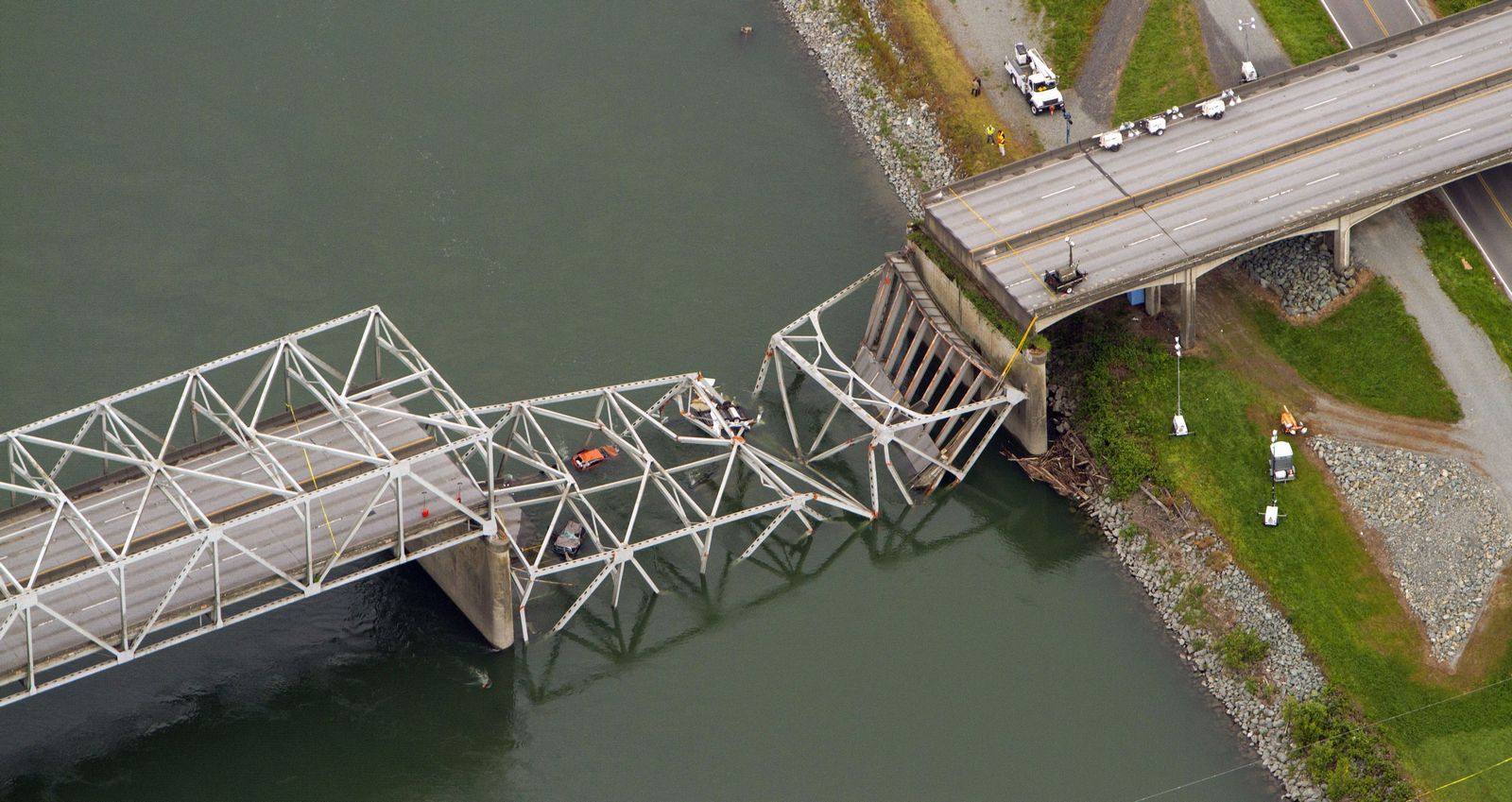Gov. Jay Inslee announces that temporary I-5 spans should be in place over the Skagit River by mid-June, with permanent repairs complete this fall

A collapsed section of the I-5 bridge over the Skagit River is seen in an aerial view Friday. Part of the bridge collapsed Thursday evening, sending cars and people into the water when a an oversized truck hit the span.
By Mike Baker and Manuel Valdes, Associated Press
SEATTLE — Federal investigators used 3-D laser scans Sunday to study what remained of a collapsed Washington state bridge as Gov. Jay Inslee announced temporary spans will be installed across the Skagit River within weeks — if plans go well.
Sunday’s announcement comes a day after the chairwoman of the National Transportation Safety Board called last week’s I-5 bridge collapse a wake-up call to the state of safety of the nation’s infrastructure and the Saturday destruction of a highway overpass in Missouri that was struck by a cargo train.
The I-5 collapse, caused by a semi-truck carrying an oversize load striking the bridge, fractured one of the major trade and travel corridors on the West Coast. The interstate connects the state with Canada, which is about an hour north of Mount Vernon, where the bridge buckled.
After the collapse, semi-trucks, travel buses and cars clogged local bridges as traffic was diverted through the small cities around the bridge. But overall, traffic was flowing as well as expected during the holiday weekend.
“We’re going to get this project done as fast as humanly possible,” Inslee, a Democrat, said Sunday. “There are no more important issue right now to the economy of the state of Washington than getting this bridge up and running.”
Inslee said he hopes the temporary spans, each with two lanes for northbound and southbound traffic, will be finished in about three weeks’ time or about mid-June. The spans will be pre-built and trucked to Mount Vernon.
The state plan also calls for a permanent span to be built and competed by autumn, officials said.
Officials say there are remaining inspections to the spans left standing to make sure they are safe to use.
The federal government is expected to cover 100 percent of the costs of the temporary bridge and 90 percent the replacement, said state Transportation Secretary Lynn Peterson.
The temporary span would be able to carry regular-sized cargos as well as cars. The speed limit would be lower than the 60 miles per hour allowed previously.
Barges arrived this weekend at the river with equipment ready to remove the mangled steel, pavement and cars in the water.
On Thursday, a semi-truck carrying an oversize load clipped a steel truss, starting the collapse of the span and sending cars and people into the cold river waters, authorities said. The three people in the cars survived with non-life threatening injuries.
An investigation by The Associated Press suggests similar accidents could happen elsewhere. Thousands of bridges around the U.S. are kept standing by engineering design, rather than sheer size or redundant protections. Such spans may be one freak accident or mistake away from collapse.
Bridge regulators call them “fracture critical” bridges, because if a single, vital component is compromised, they can crumple.
NTSB Chairwoman Debbie Hersman said such bridges and other kinds of bridges around the nation should be looked at.
“The wake-up call is really to focus on how important our infrastructure is to our nation, certainly for our commerce and keeping communities vibrant and connected,” she said Sunday, adding that when important decisions are made about infrastructure, safety should have “a seat at the table.”
Hersman said on Sunday said the bridge had withstood other over height collisions with vehicles in the past, with the most recent reported collision happening last October. She said evidence of other collisions can be seen in the spans still standing over the water.
Hersman also said a second truck with a similar cargo was traveling behind the truck involved in the collision. She said investigators are inspecting that cargo and truck to take measurements. The truck involved in the collision has also been moved off the highway on-ramp where it has been parked since Thursday.
Hersman also said investigators have traveled to Alberta, Canada to inspect the trucking company’s records.
The NTSB head also said that if the truck had been on the left lane of the southbound lanes, it likely would have cleared the bridge without a collision, but added that more precise measurements need to be taken. The bridge’s height clearance varies across it.
“We know the company was required to establish that they could clear the entire route,” Hersman said.
The truck’s cargo from Canada was headed to Alaska. Its plan was to load the cargo onto a barge in Vancouver, Wash., about 275 miles south of the border crossing. Hersman said she didn’t know why the plan called to use a port a couple of hundred miles away from other ports.
——
Associated Press Donna Gordon Blankinship contributed to this report.
